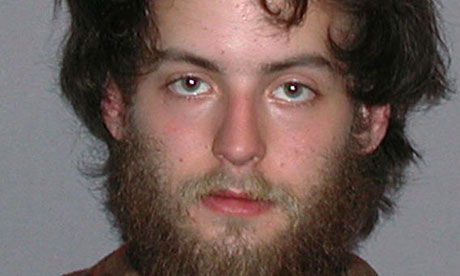Rather than target real risks of domestic terror, like neo-Nazis, the FBI entrapment machine demonises anarchists and Muslims
 Arun Gupta guardian.co.uk,
Arun Gupta guardian.co.uk,

“These defendants were found to have engaged in terrorist activities ? These sentences should send a message that when individuals decide to endanger the safety of our community, they will be held to account.”
Dettelbach, however, was trying to spin the judge’s ruling that, in fact, rebuked the government. Dowd handed down far shorter sentences than the prosecutor sought, reportedly saying that the proposed prison terms were “grotesque” and “doesn’t make any sense whatsoever”. The prosecution had asked for sentences of 30, 25 and 19 years, respectively, for Douglas Wright, 27, Brandon Baxter, 20, and Connor Stevens, 20, in the failed plot to use plastic explosives to topple the Route 82 bridge spanning Ohio‘s Cuyahoga Valley National Park on 30 April 2012.
The prosecution was banking on decades-long sentences after negotiating a minimum of nearly 16 years for co-defendant Anthony Hayne, 35, in exchange for his testimony against his four associates.Hayne, who pled guilty 25 July on three charges, was told he would serve half the time of the other defendants. Dowd’s decision sent Hayne’s lawyer scrambling the same day to withdraw the guilty plea, with sentencing now set for 30 November. (The fifth man caught in the plot, Joshua Stafford, 23, is being evaluated for mental competency.)
After Hayne agreed to testify, Wright, Baxter and Stevens accepted guilty pleas 5 September, gambling that Dowd would reduce their sentences based on mitigating factors. But this nixed the defense plan to argue entrapment, detailing how Shaquille Azir, a paid FBI informant with a 20-year criminal record, facilitated every step in the plot.
Azir molded the five’s childish bravado and drunken fantasies into terrorism. He played father figure to the lost men, providing them with jobs, housing, beer and drugs. Every time the scheme threatened to collapse into gutterpunk chaos, he kept it on track.
FBI tapes reveal Azir led the brainstorming of targets, showed them bridges to case out, pushed them to buy C-4 military-grade explosives, provided the contact for weapons, gave them money for the explosives and demanded they develop a plan because “we on the hook” for the weapons. At one point, Azir burst out in frustration at their ineptitude: “every time we meet, we leave saying, we’re doing some research. And then get back together and go back to square one.”
This case could have put on trial the post-September 11 strategy of “preventative prosecution”, in which the FBI dispatches provocateurs to infiltrate targeted religious and political groups to see what they can stir up. The targeting is not based on who are the main domestic terrorist threats, such as neo-Nazis preparing to start a race war, and violent anti-abortion fanatics. The threat assessment singles out the already-demonized, such as Muslims. Jeanne Theoharis, professor of political science at Brooklyn College and co-founder of Educators for Civil Liberties, says:
“There’s a tremendous amount of violent Christian religious speech in our airwaves and that’s considered protected. It sounds very different to the government if the speaker is a Muslim.”
Similarly, anarchists are inherently suspect. A recent FBI document calls anarchists “criminals seeking an ideology to justify their activities”, warning they were engaged in “experimentation with new tactics, weapons ? leading up to 2012 conventions”. This tone pervades the government case against Wright, Baxter and Stevens. It claims the “brothers-in-arms” were united in “hatred of the government, and shared anarchist background” and had already decided “to carry out an attack that would, in their minds, lead to a larger civil war”.
Pardiss Kebriaei, a senior attorney specializing in national security at the Center for Constitutional Rights, claims standard operating procedure in terror cases “starts with surveillance and profiling on the basis of religion, politics and national origin”. She notes parallels between the Cleveland anarchists and the “Newburgh Four”, named for the upstate New York town in which the plot was hatched. The Guardian reported they were convicted in 2010 “of an Islamic terrorist plot to blow up Jewish synagogues and shoot down military jets with missiles”, and described them as “beset by drug, criminal and mental health issues”. Kebriaei says the four men “are from the poorest community in New York, and the government was exploiting their needs”.
The Cleveland anarchists are cut from the same cloth. Lea Tolls, 47, a self-described “Occu-mom”, says, “Except for [Stevens] they were destitute. They are angry, some have mental illnesses, and there is alcoholism and abuse in their families.” The FBI dispatched Azir to an Occupy Cleveland event on 21 October 2011, “based on an initial report of potential criminal activity and threats involving anarchists”. Terry Gilbert, Stevens’ defense attorney, questions why the feds would send “a plant into a peaceful demonstration with a very ambiguous claim of criminal behavior. Once you get an informant in there, they have every motive to get a case. They are trying to make money or are working off a criminal case.”
This profile fits Azir to a T: he has filed nine bankruptcy petitions in 12 years and was indicted twice during the investigation for passing bad checks. It also fits the FBI plant in the Newburgh case, Shahed Hussain, a convicted fraudster who became an FBI asset in return for Etch-a-Sketching away his legal problems and for $100,000 in expenses and wages.
In a memo dated 14 November, Judge Dowd undercut the rationale for the investigation. The FBI’s first report from Azir stated that Doug Wright and a group of white males at the Occupy Cleveland event “were expressing displeasure at the crowd’s unwillingness to act violently”. In actuality, Dowd found that Baxter and Wright “joined the others in the nonviolent approach”.
Dowd also rejected the Bureau’s description of Wright as being in the “planning phase” to topple a bank sign from a 947-foot-tall skyscraper in downtown Cleveland, finding that he was merely expressing his “fascination with the idea of pulling pranks by using spray paint, stink bombs and smoke bombs which he heard about in the Anarchist’s Cookbook“. Dowd noted as well that Azir “facilitated the criminal conduct of the defendants”.
The Newburgh defense counsel, like the Cleveland attorneys, determined that entrapment offered the best chance of acquitting their clients. If they succeed, it will be the first time since 9/11 that entrapment has beaten a terror rap. Kebriaei says:
“Legally, entrapment is a very narrow and very difficult defense. It is very difficult for anyone to succeed in front of a jury if you’re accused of terrorism in this country.”
Entrapment turns on the question: were the accused predisposed toward violence? That’s why the government wants to equate Islam with terror and anarchism with anti-state violence: once the ideas are planted in the public’s mind, it can wave the red flags and prejudice the whole case. Theoharis says:
“Judges are not willing to challenge the government because if you take a bold stand that can mean you’re not going to move up.”
District court Judge Colleen McMahon blasted the government’s conduct in the Newburgh Four, saying:
“Only the government could have made a terrorist out of Mr Cromitie, a man whose buffoonery is positively Shakespearean in its scope.”
But, says Theoharis, the judge “wasn’t actually willing to do anything courageous”. Dowd didn’t go out on a limb either, applying terrorism enhancement charges in a pre-sentence hearing, though Gilbert says he interprets this as a tactical move. “Dowd wanted to craft a reasonable sentence that gave the government less opportunity to challenge it on appeal.”
The result, however is that the FBI continues to run rampant. To stop entrapment, says Kebriaei:
“The first step is more scrutiny of the process and how these convictions are coming about. Exposing these cases may effect prosecutorial and police practices in terms of targeting people.”
The Newburgh and Cleveland cases may eventually turn out to be a nail in the coffin of the FBI’s entrapment strategy. But it comes at the cost of nine men losing decades of their lives and nine devastated families. There are hundreds more cases like these ones, and no one knows how many still to come.
? For information on how to contact Brandon Baxter, Joshua Stafford, Connor Stevens and Douglas Wright, see cleveland4solidarity.org. For the Newburgh Four, see projectsalam.org






Leave a Reply
You must be logged in to post a comment.